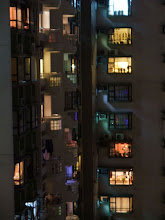Chinatowns are located due to migration. They have always acted as trading posts, apparently due to their capability in business. With the enactment of the Treaty of Peking in 1860, which opened the border for free movement, the numbers of emigration to other parts of the world from China accelerated. Coincidentally, the increasing European colonization in Asia during the mid 1800s resulted in the mass Chinese migration overseas on western ships (steamers). It has been said that from 1868 to 1939 about 6.3 million Chinese left Hong Kong as slaves for the coolie trade. What started out mostly as slavery for the gold rush, located in Australia, North America, Africa ad New Zealand, slowly turned into slavery for the railway industry.
Although the Chinese migrants all came from the coastal area of Guangzhou China, those of different dialects/ linguistic lines traveled to different parts of the world. The Taishanese and Cantonese settled in North America, Australia, Europe and Latin America; whereas the Hokkien and Teochew, moved down to Southeast Asia, Africa, Europe and later, Latin America.
Using these old maps that traced the paths of the Steam-liners taken by Chinese Immigrants, the path taken and stops made concludes the location of various 'major' / 'old' Chinatown.

 By studying these routes taken by the steam ships, we can begin to define the origin of each Chinatowns. The pattern of movement across the world map refers to the patterns of migration. Furthermore, understanding that with the spread of word by mouth or letters, more men were bound to travel to locations where they heard of success.
By studying these routes taken by the steam ships, we can begin to define the origin of each Chinatowns. The pattern of movement across the world map refers to the patterns of migration. Furthermore, understanding that with the spread of word by mouth or letters, more men were bound to travel to locations where they heard of success.Because of these occurrence, we are able to identify through the style of paifang/ archways the origins of the immigrants. (in this case it would be the regions/ villages in China.)
The paifang dates back to the Zhou Dynasty 11th Century, represented as a marker for entrances, building complexes, mausoleums, temples, bridges, parks or towns. They served as directions, decorating the neighboring community, and used to honor and commemorate deserving people or historic events.
By the Song dynasty, it became more of a decorative movement - losing its true meaning.
Surprisingly, it is arguable that the original intent for the construction of the paifang/ archway in Chinatown is to reroot oneself in the new surrounding. But over the course of history, as Chinatown grows and become globalized, the archway now serves as a means of branding for tourism and commercialization of the area (as promoted by the city-council to reduce the vice of the city due to prostitution and drug use).
The disregard of the existing context/ ground (local vernacular) shows the re-appropriation to be used to feed the need of the people to re-root or familiarize themselves on foreign soil. As ignorance is placed upon the historical (pre)existing industrial architecture the street view is made to remind of home. Resulting with a additive architecture that become inconsiderate to the existing structures or surroundings.






No comments:
Post a Comment